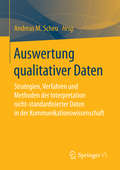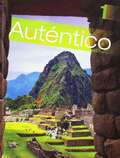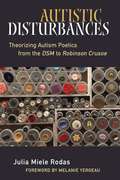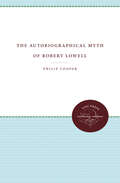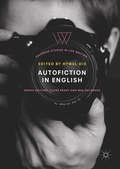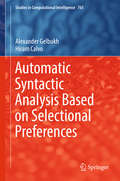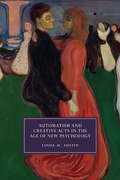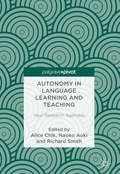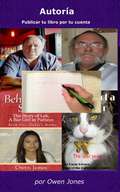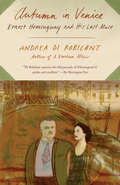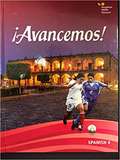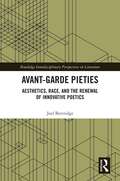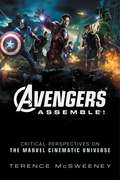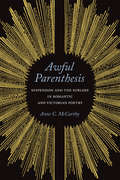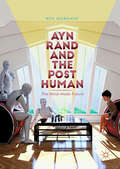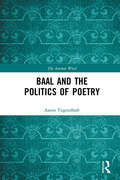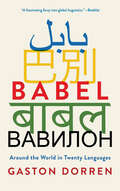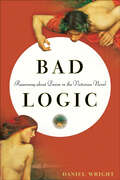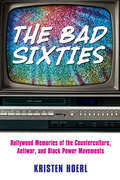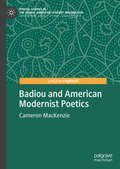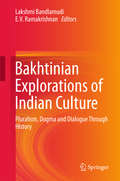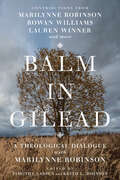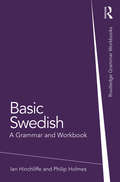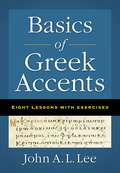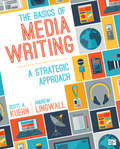- Table View
- List View
Auswertung qualitativer Daten: Strategien, Verfahren und Methoden der Interpretation nicht-standardisierter Daten in der Kommunikationswissenschaft
by Andreas M. ScheuDer Band bietet einen #65533;berblick #65533;ber qualitative Auswertungsverfahren und -strategien im Fach Kommunikationswissenschaft. Die Beitr#65533;ge besch#65533;ftigen sich mit der Auswertung unterschiedlichen Datenmaterials (z. B. Interviews, Gruppendiskussionen, audiovisuelle Daten), mit forschungspraktischen Herausforderungen in Quer- und L#65533;ngsschnittstudien, mit unterschiedlichen Strategien der Datenauswertung (z. B. Typologien, Cluster, Vergleiche, Diskursanalysen, Netzwerkanalysen) sowie verschiedenen qualitativen Perspektiven; von eher induktiven Auswertungsstrategien #65533;ber deduktive, theoriegeleitete Verfahren bis hin zu teilweise automatisierten Prozessen.
Autentico: 2018 Student Edition, Level 1 Grade 6/12
by Prentice-Hall StaffAuténtico is a comprehensive Spanish language curriculum for middle grades and high school. It immerses students in authentic Spanish language and cultural experiences through text, video, audio, and online learning. Frequent exposure to authentic resources increases engagement, improves reading proficiency, and gives students confidence to take learning beyond the classroom. Auténtico meets ACTFL World-Readiness Standards for Learning Languages, providing a powerful link between communication and culture
Autistic Disturbances: Theorizing Autism Poetics from the DSM to Robinson Crusoe (Corporealities: Discourses Of Disability)
by Julia M RodasWhile research on autism has sometimes focused on special talents or abilities, autism is typically characterized as impoverished or defective when it comes to language. Autistic Disturbances reveals the ways interpreters have failed to register the real creative valence of autistic language and offers a theoretical framework for understanding the distinctive aesthetics of autistic rhetoric and semiotics. Reinterpreting characteristic autistic verbal practices such as repetition in the context of a more widely respected literary canon, Julia Miele Rodas argues that autistic language is actually an essential part of mainstream literary aesthetics, visible in poetry by Walt Whitman and Gertrude Stein, in novels by Charlotte Brontë and Daniel Defoe, in life writing by Andy Warhol, and even in writing by figures from popular culture. Autistic Disturbances pursues these resonances and explores the tensions of language and culture that lead to the classification of some verbal expression as disordered while other, similar expression enjoys prized status as literature. It identifies the most characteristic patterns of autistic expression-repetition, monologue, ejaculation, verbal ordering or list-making, and neologism-and adopts new language to describe and reimagine these categories in aesthetically productive terms. In so doing, the book seeks to redress the place of verbal autistic language, to argue for the value and complexity of autistic ways of speaking, and to invite recognition of an obscured tradition of literary autism at the very center of Anglo-American text culture.
The Autobiographical Myth of Robert Lowell
by Philip CooperLowell's continuing productivity and his ever-increasing stature as a poet demand a new evaluation of his work, and Cooper has provided it in this penetrating study. Though Cooper's primary purpose is to demonstrate the principle of the interrelation of the poems, a secondary and equally important purpose is to analyze the significance of Lowell's most recent work.Originally published in 1970.A UNC Press Enduring Edition -- UNC Press Enduring Editions use the latest in digital technology to make available again books from our distinguished backlist that were previously out of print. These editions are published unaltered from the original, and are presented in affordable paperback formats, bringing readers both historical and cultural value.
Autofiction in English (Palgrave Studies in Life Writing)
by Hywel DixThis innovative volume establishes autofiction as a new and dynamic area of theoretical research in English. Since the term was coined by Serge Doubrovsky, autofiction has become established as a recognizable genre within the French literary pantheon. Yet unlike other areas of French theory, English-language discussion of autofiction has been relatively limited - until now. Starting out by exploring the characteristic features and definitions of autofiction from a conceptual standpoint, the collection identifies a number of cultural, historical and theoretical contexts in which the emergence of autofiction in English can be understood. In the process, it identifies what is new and distinctive about Anglophone forms of autofiction when compared to its French equivalents. These include a preoccupation with the conditions of authorship; writing after trauma; and a heightened degree of authorial self-reflexivity beyond that typically associated with postmodernism. By concluding that there is such a field as autofiction in English, it provides for the first time detailed analysis of the major works in that field and a concise historical overview of its emergence. It thus opens up new avenues in life writing and authorship research.
Automatic Syntactic Analysis Based on Selectional Preferences (Studies In Computational Intelligence #765)
by Hiram Calvo Alexander GelbukhThis book describes effective methods for automatically analyzing a sentence, based on the syntactic and semantic characteristics of the elements that form it. To tackle ambiguities, the authors use selectional preferences (SP), which measure how well two words fit together semantically in a sentence. Today, many disciplines require automatic text analysis based on the syntactic and semantic characteristics of language and as such several techniques for parsing sentences have been proposed. Which is better? In this book the authors begin with simple heuristics before moving on to more complex methods that identify nouns and verbs and then aggregate modifiers, and lastly discuss methods that can handle complex subordinate and relative clauses. During this process, several ambiguities arise. SP are commonly determined on the basis of the association between a pair of words. However, in many cases, SP depend on more words. For example, something (such as grass) may be edible, depending on who is eating it (a cow?). Moreover, things such as popcorn are usually eaten at the movies, and not in a restaurant. The authors deal with these phenomena from different points of view.
Automatism and Creative Acts in the Age of New Psychology (Cambridge Studies In Nineteenth-century Literature And Culture Ser. #111)
by Linda M. AustinThe late nineteenth century saw a re-examination of artistic creativity in response to questions surrounding the relation between human beings and automata. These questions arose from findings in the 'new psychology', physiological research that diminished the primacy of mind and viewed human action as neurological and systemic. Concentrating on British and continental culture from 1870 to 1911, this unique study explores ways in which the idea of automatism helped shape ballet, art photography, literature, and professional writing. Drawing on documents including novels and travel essays, Linda M. Austin finds a link between efforts to establish standards of artistic practice and challenges to the idea of human exceptionalism. Austin presents each artistic discipline as an example of the same process: creation that should be intended, but involving actions that evade mental control. This study considers how late nineteenth-century literature and arts tackled the scientific question, 'Are we automata?'
Autonomy in Language Learning and Teaching: New Research Agendas
by Richard Smith Alice Chik Naoko AokiThis book seeks to expand the research agendas on autonomy in language learning and teaching in diverse contexts, by examining the present landscape of established studies, identifying research gaps and providing practical future research directions. Based on empirical studies, it explores research agendas in five emerging domains: language learning and teaching in developing countries; social censure and teacher autonomy; learner autonomy and groups; learner autonomy and digital practice; and finally, learner autonomy and space. In doing so, it sheds new light on the impact of digital media, group dynamics and the application of ecological perspectives on learner autonomy. The contributors present a novel reconsideration of new learning affordances, and their discussion of spatial dimensions provides much needed expansion in the field. This book will have international appeal and provide an invaluable resource for students and scholars of second language learning and higher education, as well as teacher educators. Chapter 2 of this book is open access under a CC BY 4. 0 license via link. springer. com.
Autoría
by Gabriela Garcia Calderon Owen JonesCómo publicar tu libro por tu cuenta Este libro es para todos esos autores que se sienten intimidados de publicar sus libros, ya sea en forma impresa, formato electrónico o ambos. He publicado más de cien libros con los priincipales editores y distribuidores, así que quedé sorprendido cuando supe que algunos escritores excelentes postergan autopublicarse porque les parece una tarea demasiado confusa y difícil, así que le pagan a otros para que lo hagan. Puedo entenderlo si un autor quiere ahorrar tiempo, así que el objetivo de este libro es ayudar a quienes quieren emprender la tarea pero no saben cómo. Es muy satisfactorio concebir la idea de un libro, escribirlo y luego publicarlo tú mismo, y con la ayuda de este libro. es exactamente lo que podrás hacer. Acá aprenderás cómo publicar en los principales distribuidores, como Amazon, iBookstore, Barnes and Noble, Lulu, Nook, Kindle, Smashwords y XinXii.
Autumn in Venice: Ernest Hemingway and His Last Muse
by Andrea Di RobilantThe acclaimed author of A Venetian Affair now gives us the remarkable story of Hemingway's love affair with both the city of Venice and the muse he found there--a vivacious eighteen-year-old who inspired the man thirty years her senior to complete his great final work.In the fall of 1948 Hemingway and his fourth wife traveled for the first time to Venice, which Hemingway called "a goddam wonderful city." He was a year shy of his fiftieth birthday and hadn't published a novel in nearly a decade. At a duck shoot in the lagoon he met and fell in love with Adriana Ivancich, a striking Venetian girl just out of finishing school. Di Robilant--whose great-uncle moved in Hemingway's revolving circle of bon vivants, aristocrats, and artists--re-creates with sparkling clarity this surprising, years-long relationship. Hemingway used Adriana as the model for Renata in Across the River and into the Trees, and continued to visit Venice to see her; when the Ivanciches traveled to Cuba, Adriana was there as he wrote The Old Man and the Sea. This illuminating story of writer and muse--which also examines the cost to a young woman of her association with a larger-than-life literary celebrity--is an intimate look at the fractured heart and changing art of Hemingway in his fifties.
Avant-Garde Pieties: Aesthetics, Race, and the Renewal of Innovative Poetics (Routledge Interdisciplinary Perspectives on Literature)
by Joel BettridgeAvant-Garde Pieties tells a new story about innovative poetry; it argues that the avant-garde-now more than a century old-persists in its ability to nurture interesting, provocative, meaningful, and moving poems, despite its profound cultural failings and its self-devouring theoretical compulsions. It can do so because a humanistic strain of its radical poetics compels adherents to argue over the meaning of their shared political and aesthetic beliefs. In ways that can be productively thought of as religious in structure, this process fosters a perpetual state of crisis and renewal, always returning innovative poetry to its founding modernist commitments as a way to debate what the avant-garde is-what it should and does look like, and what it should and does value. Consequently, Avant-Garde Pieties makes way for a radical poetics defined not by formal gestures, but by its debate with itself about itself. It is a debate that honors the tradition's intellectual founding as well as its cultural present, which includes aesthetic multiformity, racialized and gendered modes of authorship, experiences of the sacred, political activism, and generosity in critical disagreement.
Avengers Assemble!: Critical Perspectives on the Marvel Cinematic Universe
by Terence McSweeneyWe are living in the age of the superhero and we cannot deny it. <P><P>Avengers Assemble! is a vibrant and theoretically informed interrogation of one of the defining and most financially successful film franchises of the new millennium. In the first single-authored monograph on the topic of the Marvel cinematic universe, Terence McSweeney asks, "Why has the superhero genre reemerged so emphatically in recent years?" In an age where people have stopped going to the cinema as frequently as they used to, they returned to it in droves for the superhero film. What is it about these films that has resonated with audiences all around the globe? Are they just disposable pop culture artifacts or might they have something interesting to say about the fears and anxieties of the world we live in today? <P><P>Beginning with Iron Man in 2008, this study provocatively explores both the cinematic and the televisual branches of the series across ten dynamic and original chapters from a diverse range of critical perspectives which analyse their status as an embodiment of the changing industrial practices of the blockbuster film and their symbolic potency as affective cultural artifacts that are profoundly immersed in the turbulent political climate of their era.
Awful Parenthesis: Suspension and the Sublime in Romantic and Victorian Poetry
by Anne C. McCarthyWhether the rapt trances of Romanticism or the corpse-like figures that confounded Victorian science and religion, nineteenth-century depictions of bodies in suspended animation are read as manifestations of broader concerns about the unknowable in Anne C. McCarthy’s Awful Parenthesis. Examining various aesthetics of suspension in the works of poets such as Coleridge, Shelley, Tennyson, and Christina Rossetti, McCarthy shares important insights into the nineteenth-century fascination with the sublime. Attentive to differences between "Romantic" and "Victorian" articulations of suspension, Awful Parenthesis offers a critical alternative to assumptions about periodization. While investigating various conceptualizations of suspension, including the suspension of disbelief, suspended animation, trance, paralysis, pause, and dilatation, McCarthy provides historically-aware close readings of nineteenth-century poems in conversation with prose genres that include devotional works, philosophy, travel writing, and periodical fiction. Awful Parenthesis reveals the cultural obsession with the aesthetics of suspension as a response to an expanding, incoherent world in crisis, one where the audience is both active participant and passive onlooker.
Ayn Rand and the Posthuman: The Mind-made Future
by Ben MurnaneAyn Rand and the Posthuman is a study of the American novelist’s relationship with twenty-first-century ideas about technology. Rand wrote science fiction that has inspired Silicon Valley entrepreneurs, politicians, and economists. Ben Murnane demonstrates Rand’s connection to, and impact on, those with a “posthuman” vision, in which human and machine merge. The text examines the philosophical intersections between Rand’s philosophy of Objectivism and posthumanism, and Rand’s influence on transhumanism, a major branch of posthumanist thought. The book further investigates Rand’s presence and portrayal in various examples of posthumanist science fiction, including Gene Roddenberry’s Andromeda, popular videogame BioShock, and Zoltan Istvan’s novel The Transhumanist Wager. Considering Rand’s influence from a cultural, political, technological, and economic perspective, this study throws light on an under-documented but highly significant aspect of Rand’s legacy.
Baal and the Politics of Poetry (The Ancient Word)
by Aaron TugendhaftBaal and the Politics of Poetry provides a thoroughly new interpretation of the Ugaritic Baal Cycle that simultaneously inaugurates an innovative approach to studying ancient Near Eastern literature within the political context of its production. The book argues that the poem, written in the last decades of the Bronze Age, takes aim at the reigning political-theological norms of its day and uses the depiction of a divine world to educate its audience about the nature of human politics. By attuning ourselves to the specific historical context of this one poem, we can develop more nuanced appreciation of how poetry, politics, and religion have interacted—in antiquity, and beyond.
Babel: Around the World in Twenty Languages
by Gaston Dorren“Babel is an endlessly interesting book, and you don’t have to have any linguistic training to enjoy it . . . it’s just so much fun to read.” —NPREnglish is the world language, except that 80 percent of the world doesn’t speak it. Linguist Gaston Dorren calculates that to speak fluently with half of the world’s people in their mother tongues, you’d need to know no fewer than twenty languages. In Babel, he sets out to explore these top twenty world languages, which range from the familiar (French, Spanish) to the surprising (Malay, Javanese, Bengali). Whisking readers along on a delightful journey, he traces how these languages rose to greatness while others fell away, and shows how speakers today handle the foibles of their mother tongues. Whether showcasing tongue-tying phonetics, elegant but complicated writing scripts, or mind-bending quirks of grammar, Babel vividly illustrates that mother tongues are like nations: each has its own customs and beliefs that seem as self-evident to those born into it as they are surprising to outsiders. Babel reveals why modern Turks can’t read books that are a mere 75 years old, what it means in practice for Russian and English to be relatives, and how Japanese developed separate “dialects” for men and women. Dorren also shares his experiences studying Vietnamese in Hanoi, debunks ten myths about Chinese characters, and discovers the region where Swahili became the lingua franca. Witty and utterly fascinating, Babel will change how you look at and listen to the world.“Word nerds of every strain will enjoy this wildly entertaining linguistic study.” —Publishers Weekly (starred review)
Bad Logic: Reasoning about Desire in the Victorian Novel
by Daniel WrightHow did the Victorians think about love and desire?"Reader, I married him," Jane Eyre famously says of her beloved Mr. Rochester near the end of Charlotte Brontë’s novel. But why does she do it, we might logically ask, after all he’s put her through? The Victorian realist novel privileges the marriage plot, in which love and desire are represented as formative social experiences. Yet how novelists depict their characters reasoning about that erotic desire—making something intelligible and ethically meaningful out of the aspect of interior life that would seem most essentially embodied, singular, and nonlinguistic—remains a difficult question.In Bad Logic, Daniel Wright addresses this paradox, investigating how the Victorian novel represented reasoning about desire without diluting its intensity or making it mechanical. Connecting problems of sexuality to questions of logic and language, Wright posits that forms of reasoning that seem fuzzy, opaque, difficult, or simply "bad" can function as surprisingly rich mechanisms for speaking and thinking about erotic desire. These forms of "bad logic" surrounding sexuality ought not be read as mistakes, fallacies, or symptoms of sexual repression, Wright asserts, but rather as useful forms through which novelists illustrate the complexities of erotic desire.Offering close readings of canonical writers Charlotte Brontë, Anthony Trollope, George Eliot, and Henry James, Bad Logic contextualizes their work within the historical development of the philosophy of language and the theory of sexuality. This book will interest a range of scholars working in Victorian literature, gender and sexuality studies, and interdisciplinary approaches to literature and philosophy.
The Bad Sixties: Hollywood Memories of the Counterculture, Antiwar, and Black Power Movements (Race, Rhetoric, and Media Series)
by Kristen HoerlWinner of the 2018 Book Award from the American Studies Division of the National Communication AssociationOngoing interest in the turmoil of the 1960s clearly demonstrates how these social conflicts continue to affect contemporary politics. In The Bad Sixties: Hollywood Memories of the Counterculture, Antiwar, and Black Power Movements, Kristen Hoerl focuses on fictionalized portrayals of 1960s activism in popular television and film. Hoerl shows how Hollywood has perpetuated politics deploring the detrimental consequences of the 1960s on traditional American values. During the decade, people collectively raised fundamental questions about the limits of democracy under capitalism. But Hollywood has proved dismissive, if not adversarial, to the role of dissent in fostering progressive social change.Film and television are salient resources of shared understanding for audiences born after the 1960s because movies and television programs are the most accessible visual medium for observing the decade's social movements. Hoerl indicates that a variety of television programs, such as Family Ties, The Wonder Years, and Law and Order, along with Hollywood films, including Forrest Gump, have reinforced images of the "bad sixties." These stories portray a period in which urban riots, antiwar protests, sexual experimentation, drug abuse, and feminism led to national division and moral decay. According to Hoerl, these messages supply distorted civics lessons about what we should value and how we might legitimately participate in our democracy.These warped messages contribute to "selective amnesia," a term that stresses how popular media renders radical ideas and political projects null or nonexistent. Selective amnesia removes the spectacular events and figures that define the late-1960s from their motives and context, flattening their meaning into reductive stereotypes. Despite popular television and film, Hoerl explains, memory of 1960s activism still offers a potent resource for imagining how we can strive collectively to achieve social justice and equality.
Badiou and American Modernist Poetics (Pivotal Studies In The Global American Literary Imagination Ser.)
by Cameron MacKenzieBadiou and American Modernist Poetics explores the correspondence between Alain Badiou's thinking on art and that of the canonical modernists T.S. Eliot, Wallace Stevens, and Ezra Pound. Utilizing a multidisciplinary approach, the text engages with themes of the void, mastery, and place present in both modernist poetry and in Badiou’s philosophy. Through an examination of classic modernist texts, Cameron MacKenzie reveals that where Badiou hopes to go, the modernists have already been.
Bakhtinian Explorations of Indian Culture: Pluralism, Dogma and Dialogue Through History
by E. V. Ramakrishnan Lakshmi BandlamudiThis volume, an important contribution to dialogic and Bakhtin studies, shows the natural fit between Bakhtin’s ideas and the pluralistic culture of India to a global academic audience. It is premised on the fact that long before principles of dialogism took shape in the Western world, these ideas, though not labelled as such, were an integral part of intellectual histories in India. Bakhtin’s ideas and intellectual traditions of India stand under the same banner of plurality, open-endedness and diversity of languages and social speech types and, therefore, the affinity between the thinker and the culture seems natural. Rather than being a mechanical import of Bakhtin’s ideas, it is an occasion to reclaim, reactivate and reenergize inherent dialogicality in the Indian cultural, historical and philosophical histories. Bakhtin is not an incidental figure, for he offers precise analytical tools to make sense of the incredibly complex differences at every level in the cultural life of India. Indian heterodoxy lends well to a Bakhtinian reading and analysis and the papers herein attest to this. The papers range from how ideas from Indo-European philology reached Bakhtin through a circuitous route, to responses to Bakhtin’s thought on the carnival from the philosophical perspectives of Abhinavagupta, to a Bakhtinian reading of literary texts from India. The volume also includes an essay on ‘translation as dialogue’ – an issue central to multilingual cultures – and on inherent dialogicality in the long intellectual traditions in India.
Balm in Gilead: A Theological Dialogue with Marilynne Robinson (Wheaton Theology Conference Series)
by Marilynne Robinson Timothy Larsen Rowan Williams Timothy George Lauren F. Winner Keith L. Johnson Han-luen Kantzer Komline Patricia Andujo Tiffany Eberle KrinerPulitzer Prize–winning novelist Marilynne Robinson is one of the most eminent public intellectuals in America today. In addition to literary elegance, her trilogy of novels (Gilead, Home, and Lila) and her collections of essays offer probing meditations on the Christian faith. Many of these reflections are grounded in her belief that the sixteenth-century Protestant Reformer John Calvin still deserves a hearing in the twenty-first century. This volume, based on the 2018 Wheaton Theology Conference, brings together the thoughts of leading theologians, historians, literary scholars, and church leaders who engaged in theological dialogue with Robinson's published work—and with the author herself.
Basic Swedish: A Grammar and Workbook (Grammar Workbooks)
by Ian Hinchliffe Philip HolmesBasic Swedish: A Grammar and Workbook combines an accessible basic reference grammar and related exercises in one volume, and covers most of the topics that students might expect to deal with in their first year of learning Swedish. Each of the 25 units discusses one or more grammar topics, with examples that are subsequently practised in the exercises that follow. The book introduces the contemporary language against a backdrop of Swedish culture, society, geography, customs and history. Each unit ends with a cultural text that outlines an aspect of Swedish culture and exemplifies and consolidates the grammar topic examined in the unit. Features include: clear grammatical explanations with examples in Swedish and English vocabulary based on a major corpus of written Swedish in order to guarantee authenticity and relevance cross-references to other units over 100 exercises with a key to all the correct answers full vocabulary list at the end of the book. The book is suitable both for independent study and for class use. It can be used by absolute beginners and those who have advanced a little further.
Basics of Greek Accents: Eight Lessons with Exercises
by John A. LeeBasics of Greek Accents by John A. L. Lee is a compact, student-friendly, and practical guide to accents for students of both classical and biblical Greek. In eight simple lessons students will learn the basics of ancient Greek accentuation.Ideal for beginners who are just learning the language or for intermediate students who have learned some Greek but are unsure of their accents this handy resource avoids theory and concentrates on taking the learner through the essentials in a natural sequence and reinforces learning by means of simple exercises.
The Basics of Media Writing: A Strategic Approach
by Scott A. Kuehn James Andrew LingwallThe Basics of Media Writing: A Strategic Approach helps readers develop the essential writing skills and professional habits needed to succeed in 21st-century media careers. This research-driven, strategy-based media writing textbook digs deeply into how media professionals think and write in journalism, public relations, advertising, and other forms of strategic communication. Authors Scott A. Kuehn and Andrew Lingwall have created two comprehensive writing models to help students overcome their problems in finding and developing story topics by giving them “starting points” to begin writing. The Professional Strategy Triangle model shows students how to think critically about the audience, the situation, and the message before starting a news story or persuasive piece and the FAJA four-point model asks students a series of questions about their story type (Fact, Analysis, Judgment, or Action) to guide them to the right angle or organizational structure for their message. Rooted in classical rhetorical methods, this step-by-step technique enables readers to strategically approach each writing task, no matter the format.
